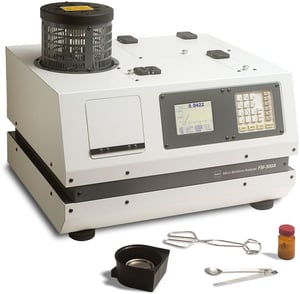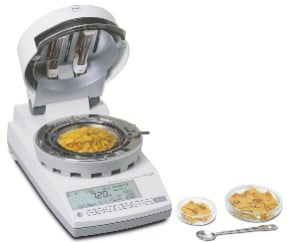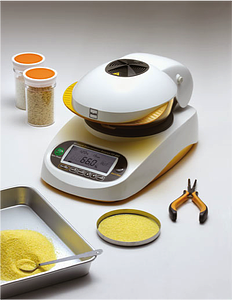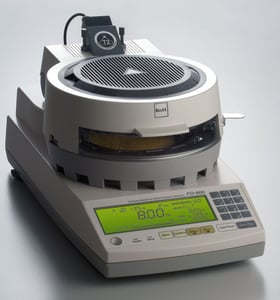 A moisture balance is one method used to determine the level of moisture in a particular sample. It’s considered a primary method of measuring moisture that relies on each sample’s weight loss on drying (LOD).
A moisture balance is one method used to determine the level of moisture in a particular sample. It’s considered a primary method of measuring moisture that relies on each sample’s weight loss on drying (LOD).
This means that there is a preliminary weight measurement taken of the sample, and when it is fully dried, the sample is weighed again. When the measurements are compared, the difference in weight is equal to the amount of moisture in the starting sample.
All technicalities aside, what does this mean? And in a world where near-infrared (NIR) technology is taking over the moisture meter industry, when is it the right time to rely on these moisture balances, and other LOD methods for accurate readings?
Moisture balances are still a highly important part of the industry of taking precise moisture readings. Here’s why:
More Reliable Than Manual LOD Testing or a Universal Moisture Meter
Loss on drying moisture testing doesn’t lie: it gives a wholly accurate reading of moisture content by testing the sample before, during, and after drying, even on the most challenging samples to measure. But when it’s done manually without a moisture balance, errors can occur.
Weights can be recorded wrong, samples may not have dried thoroughly, and calculations can be done incorrectly. Manual LOD testing is not as reliable as using a moisture determination balance.
As far as NIR moisture meters and some universal moisture testers go, these are perfect for certain uses. Drywall and concrete moisture meters, for example, are the right tool for the job on construction sites and can be used in countless ways.
In addition, if the sample can't be altered or harmed, and instant moisture meter (like our NIR and "electrical" meters) is the solution. However, some of these moisture meters are not the right tools for certain jobs. When readings are exceedingly hard to take with other kinds of moisture meters like universal moisture meters, moisture balances are the way to go. As an example, if the application is purely R&D, and the product "recipe" changes each time, an NIR or electrical meter will not be practical. These machines require initial calibration, so if the product is constantly being changed, it's not productive to try to calibrate the instant meters.
Why? It’s just not worth taking so much additional time for these quick, simple readings in order to calibrate a second moisture measurement device, like a universal moisture meter. Why set up and calibrate a new device when your moisture analyzer is already prepped to work and is so accurate?
How the Food Industry Can Benefit From a Moisture Balance
Moisture meters are an important tool in food processing. Within the food industry, where multiple kinds of moisture readings are necessary throughout the manufacturing process, a moisture balance is a reliable, failsafe method to check moisture levels during production.
There are many ways that moisture levels can impact both the quality of your finished product and the cost of your bottom line. A moisture balance is a great way to ensure that this doesn’t happen. Here are a few major ways that moisture can affect the manufacturing process in the food industry (and why a moisture balance will give you a better reading!):
-
Food texture: Extra moisture in foods like bread or pasta can make them difficult to manage or prepare if there is too much moisture, while other foods like cereals and even your beloved dog’s favorite food can be crumbly (and stale) if they are too dry.
A traditional universal moisture meter with probes won’t correctly read levels of dry foods that come in small pieces, like cereals or dry pet food - because it doesn’t take a reading of the moisture level of the entire sample - only the piece or pieces that come into contact with the probes. Each piece can have a different moisture content level, and in order to get an accurate reading of the moisture level, you would have to take moisture readings of many, many pieces.
Taking a larger sample than just a single piece, as you would with a moisture balance, gives you a better picture of the overall moisture content. Checking the moisture level with a moisture balance and determining the LOD moisture is a fairly reliable way to ensure that the texture of your final product is spot on, not to mention delicious.
An even better way? With a NIR moisture meter, which provides superior moisture readings of the sample as a whole. In one reading, a NIR moisture meter is able to perceive the total moisture content - with improved accuracy and without the wait time. This means you get superior information, and as a result, a superior quality product.
-
Shelf life: When a product has a high moisture content, it has a shorter shelf life. This is why dried granola or cereal, or dehydrated lentils can stay in your pantry much longer than freshly baked bread. So if a batch of barley or milled flour has not been fully dried?
It won’t hold up in your consumers’ cabinets nearly as long as if it has been dried to the exact specifications. And if your product doesn’t hold up the way consumers expect it too? It’s your brand’s reputation on the line.
Again, testing moisture levels in each run of your product during the manufacturing and packaging process keeps a too-moist product from hitting the shelves.
Pet food mixture that is too moist, and is being turned into pellets can soften and clump together, making it hard for the mixture to go through the die holes meant to extrude regular-sized pellets.
If you haven't integrated one of our inline instruments into your mixing and extruding line, LOD is a great method to learn the moisture content for these hard-to-read samples. It provides an accurate reading of this mixture before it goes through the extruder. By learning the LOD levels, you can know the exact moisture content to use to optimize processing. Doing this type of testing may help you justify the need for real-time testing and automation.
-
Cost of processing: Many ingredients are sold by weight, and if you’re paying for each item by weight, or shipping based on weight, having too little moisture in your product can add up. This can end up costing you extra money for ingredients, materials, and shipping. It’s vital to test moisture levels to save yourself these extra costs. Ideally, you'd like to ship as much water as possible, while maintaining the shelf-life and other specifications required.
-
Food Safety Regulations: There are a host of food safety regulations to meet, and excess moisture can lead to microbial growth, putting your consumers in danger, and your brand in jeopardy. A moisture balance ensures that you are not putting yourself or your customers at risk.
With products like cereals, grains, or even bread, a universal moisture meter is not a great way to get accurate moisture readings, where moisture levels may be different from morsel to morsel. Taking a moisture reading with a traditional moisture meter will only give you an accurate reading of that individual piece.
Using a moisture balance instead of a universal moisture meter allows you to discover the true moisture level of a larger sample over just the level of a singular piece or morsel. The LOD method and a moisture balance will not only give you a better picture of the overall moisture content but a better final product as well.
-
Ease of processing: In the same way that too much or too little moisture can affect the finished texture, a product that is too moist or too dry can be hard to manage during processing. A too-moist dough will be sticky and harder to break into individual portions.
Other Industries
When else is it beneficial for a company to use a moisture balance to take moisture content readings? Here are a few industries that can benefit from the use of a moisture balance:
Pharmaceuticals: Like many foods, certain pharmaceutical products can be negatively impacted by too much moisture. The shelf life, and even potency, of drugs that consumers rely on for their health and comfort, can be impacted by the wrong moisture levels.
Plastic Powders and Pellets: It’s vital for plastic products to be made of the highest quality. With the wrong combination or levels of polymers, plastic can be brittle and unreliable, and precision is key to the overall outcome of the finished product.
Plastic pellets contain 100 times less moisture than most food products. A high-quality moisture balance is the only way to accurately measure the LOD changes in moisture levels when they change in such small amounts, and when precise measurements are vital.
Why is this? In addition to being a reliable, accurate way to determine the moisture levels in plastic, ASTM International, an international organization formerly called the American Society for Testing and Materials, has qualified the LOD method as an approved method for determining moisture levels in plastic. Here’s why:
Incorrect moisture levels in plastic resins can result in an inferior finished product. And with only trace amounts of moisture potentially present in plastic resin, only a moisture balance can take an accurate reading of moisture levels, since it measures by weight. Too much or too little moisture in a plastic resin majorly jeopardizes the quality.
When this level of accuracy is important to the finished product, a micro moisture analyzer like the FM300 is the perfect tool.
Chemicals: Like plastics, chemicals rely on accuracy at minute levels. When dealing with chemicals, even the smallest variance in proportions can have catastrophic results.
LOD moisture methods can test chemical reactions as test samples are heated and dried, providing you with correct moisture levels and accurate measurements, even at the tiniest weight.
So what's the bottom line? When your products are difficult to measure, and when the smallest difference in moisture levels is crucial to the final outcome, a moisture balance is the most reliable way to get a reading that you can trust.
Have a question about how you can use LOD methods for the best possible outcome? Our engineers would love to help! Contact us today to see how a moisture balance is the right choice for you!



